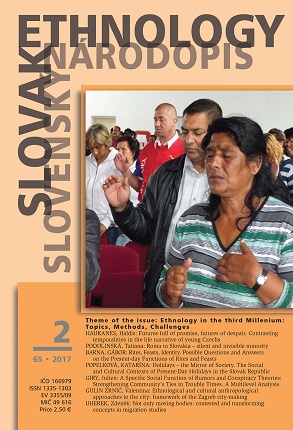Rites, feasts, identity. possible questions and answers on the present-day functions of rites and feasts
Rites, feasts, identity. possible questions and answers on the present-day functions of rites and feasts
Author(s): Gábor BarnaSubject(s): Customs / Folklore, Cultural Anthropology / Ethnology
Published by: SAV - Slovenská akadémia vied - Ústav etnológie a sociálnej antropológie Slovenskej akadémie vied
Keywords: rites; feasts; identities; church holidays; desacralisation; fragmentation; Central Europe
Summary/Abstract: What is it that makes rites important in our individual and community lives? What can this role be? Is it to make occasions more festive? What makes an occasion festive? Does celebrating mean to live with rites and use rites? How does the use of rites or rituals make an occasion more festive? What is the role of the feast and celebration at the level and in the life of the individual and the group (family, settlement, state, nation)? Why is it that we can feel our times to be an age of festivals (=special feasts)? What does this increase mean? These questions already point to the possible direction for answers, namely that rites can be the vehicles of important elements of content that make them necessary in all ages and all social systems: this content characteristic at the same time also emphasises the social role and function of rites. At this point the world of rites and feasts is connected to the levels of public life, power and politics. Rites and feasts are in constant movement and change. Rites have become a subject attracting multidisciplinary interest with many new approaches. Among the functions of rites it is mainly their expressive, social and renewal role that enables the creation of individual and community identities. Here the rite may be connected with the feast that breaks away from the routine and frame of everyday life and offers the possibility of practising it. The English expressions ‘holiday’ and ‘feast’ reflect the dual nature of the concept: a ‘holy day’, a time of freedom, time that is not controlled, as well as the excesses that accompany such events. It lifts the person celebrating it out of the everyday, weekday routine, and makes them part of this special time. Today we are witnessing the desacralisation, fragmentation and individualisation of rites and feasts. Their religious/Christian nature is pushed into the background and new desacralised feasts have appeared and are taking shape. Since the turn of the 19th to 20th century national and state days have come to increasingly predominate in the order of feasts and the dominance of civil and ideological celebration can be observed. The religious, state and national days have been shaping and dividing communities since the 19th century. The mobility appearing at all levels of society also opens up a new possibility for integration along which new feasts can appear creating what are now a whole series of local festivals. The social acceptance of the new order of feasts reflects the acceptance of the social order. Science has also become a force shaping identity, celebrating itself and its institutions with the rites of scientific conferences. In this way the feast with its rites can shape religious, national, political, regional and local, group and individual identities.
Journal: Slovenský národopis
- Issue Year: 65/2017
- Issue No: 2
- Page Range: 158-170
- Page Count: 13
- Language: English

